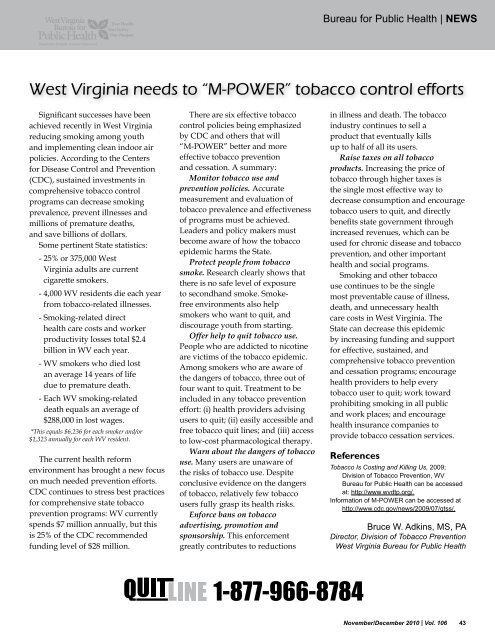Healthcare - West Virginia State Medical Association
Healthcare - West Virginia State Medical Association
Healthcare - West Virginia State Medical Association
You also want an ePaper? Increase the reach of your titles
YUMPU automatically turns print PDFs into web optimized ePapers that Google loves.
Bureau for Public Health | NEWS<strong>West</strong> <strong>Virginia</strong> needs to “M-POWER” tobacco control effortsSignificant successes have beenachieved recently in <strong>West</strong> <strong>Virginia</strong>reducing smoking among youthand implementing clean indoor airpolicies. According to the Centersfor Disease Control and Prevention(CDC), sustained investments incomprehensive tobacco controlprograms can decrease smokingprevalence, prevent illnesses andmillions of premature deaths,and save billions of dollars.Some pertinent <strong>State</strong> statistics:- 25% or 375,000 <strong>West</strong><strong>Virginia</strong> adults are currentcigarette smokers.- 4,000 WV residents die each yearfrom tobacco-related illnesses.- Smoking-related directhealth care costs and workerproductivity losses total $2.4billion in WV each year.- WV smokers who died lostan average 14 years of lifedue to premature death.- Each WV smoking-relateddeath equals an average of$288,000 in lost wages.*This equals $6,236 for each smoker and/or$1,323 annually for each WV resident.The current health reformenvironment has brought a new focuson much needed prevention efforts.CDC continues to stress best practicesfor comprehensive state tobaccoprevention programs: WV currentlyspends $7 million annually, but thisis 25% of the CDC recommendedfunding level of $28 million.There are six effective tobaccocontrol policies being emphasizedby CDC and others that will“M-POWER” better and moreeffective tobacco preventionand cessation. A summary:Monitor tobacco use andprevention policies. Accuratemeasurement and evaluation oftobacco prevalence and effectivenessof programs must be achieved.Leaders and policy makers mustbecome aware of how the tobaccoepidemic harms the <strong>State</strong>.Protect people from tobaccosmoke. Research clearly shows thatthere is no safe level of exposureto secondhand smoke. Smokefreeenvironments also helpsmokers who want to quit, anddiscourage youth from starting.Offer help to quit tobacco use.People who are addicted to nicotineare victims of the tobacco epidemic.Among smokers who are aware ofthe dangers of tobacco, three out offour want to quit. Treatment to beincluded in any tobacco preventioneffort: (i) health providers advisingusers to quit; (ii) easily accessible andfree tobacco quit lines; and (iii) accessto low-cost pharmacological therapy.Warn about the dangers of tobaccouse. Many users are unaware ofthe risks of tobacco use. Despiteconclusive evidence on the dangersof tobacco, relatively few tobaccousers fully grasp its health risks.Enforce bans on tobaccoadvertising, promotion andsponsorship. This enforcementgreatly contributes to reductionsin illness and death. The tobaccoindustry continues to sell aproduct that eventually killsup to half of all its users.Raise taxes on all tobaccoproducts. Increasing the price oftobacco through higher taxes isthe single most effective way todecrease consumption and encouragetobacco users to quit, and directlybenefits state government throughincreased revenues, which can beused for chronic disease and tobaccoprevention, and other importanthealth and social programs.Smoking and other tobaccouse continues to be the singlemost preventable cause of illness,death, and unnecessary healthcare costs in <strong>West</strong> <strong>Virginia</strong>. The<strong>State</strong> can decrease this epidemicby increasing funding and supportfor effective, sustained, andcomprehensive tobacco preventionand cessation programs; encouragehealth providers to help everytobacco user to quit; work towardprohibiting smoking in all publicand work places; and encouragehealth insurance companies toprovide tobacco cessation services.ReferencesTobacco Is Costing and Killing Us, 2009;Division of Tobacco Prevention, WVBureau for Public Health can be accessedat: http://www.wvdtp.org/.Information of M-POWER can be accessed athttp://www.cdc.gov/news/2009/07/gtss/.Bruce W. Adkins, MS, PADirector, Division of Tobacco Prevention<strong>West</strong> <strong>Virginia</strong> Bureau for Public HealthNovember/December 2010 | Vol. 1063















